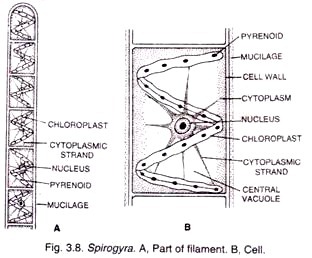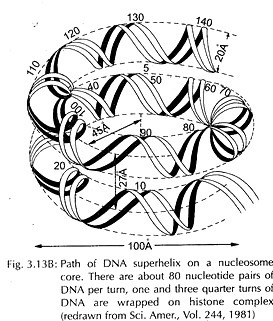The following points highlight the top three types of RNA. The types of RNA are: 1. Transfer RNA (tRNA) 2. Messenger RNA (mRNA) and 3. Ribosomal RNA (rRNA).
Contents
RNA Type # 1. Transfer RNA (tRNA):
It delivers amino acids to ribosome and decodes the information of mRNA. Each nucleotide triplet codon on mRNA represents an amino acid. The tRNA plays the role of an adaptor and matches each codon to its particular amino acid in the cytopolasmic pool.
The tRNA has two properties:
(a) It represents a single amino acid to which it binds covalently.
(b) It has two sites. One is a trinucleotide sequence called anticodon, which is complementary to the codon of mRNA. The codon and anticodon form base pairs with each other. The other is amino acid binding site.
There are many different kinds of tRNA molecules in a cell. Each tRNA is named after the amino acid it carries. For example if tRNA carries amino acid tyrosine it is written as tRNATyr.Sometimes there are more than one tRNA for an amino acid, then it is denoted as tRNA1Try and tRNA2Try. A minimum of 32 tRNAs are required to translate all 61 codons.
The tRNA charged with an amino acid is called amino acyl tRNA.
Clover Leaf Structure of tRNA:
The primary structure of all tRNA molecules is small, linear, single stranded nucleic acid ranging in size from 73 to 93 nucleotides. The tRNA due to its property of having stretches of complementary base pairs forms secondary structure, which is in the form of a cloverleaf.
Several regions of the single stranded molecule form double stranded stems or arms and single stranded loops due to folding of various regions of the molecule. These double stranded stems have complementary base pairs. A typical tRNA has bases numbering from 1-76, using the standard numbering convention where position 1 is the 5′ end and 76 is the 3′ end.
The various regions of the clover leaf model of tRNA are as follows:
1. Amino acid arm:
It has a seven base pairs stem formed by base pairing between 5′ and 3′ ends of tRNA. At 3′ end a sequence of 5′-CCA-3′ is added. This is called CCA arm or amino acid acceptor arm. Amino acid binds to this arm during protein synthesis.
2. D-arm:
Going from 5′ to 3′ direction or anticlockwise direction, next arm is D-arm. It has a 3 to 4 base pair stem and a loop called D-loop or DHU-loop. It contains a modified base dihydrouracil.
3. Anticodon arm:
Next is the arm which lies opposite to the acceptor arm. It has a five base pair stem and a loop in which there are three adjacent nucleotides called anticodon which are complementary to the codon of mRNA.
4. An extra arm:
Next lies an extra arm which consists of 3-21 bases. Depending upon the length, extra arms are of two types, small extra arm with 3-5 bases and other a large arm having 13-21 bases.
5. T-arm or TψC arm:
It has a modified base pseudouridine ψ. It has a five base pair stem with a loop.
There are about 50 different types of modified bases in different tRNAs, but four bases are more common. One is ribothymidine which contains thymine which is not found in RNA. Other modified bases are pseudouridine ψ, dihyrouridine and inosine.
Three Dimensional Structure of tRNA:
X-ray crystallographic analysis of tRNA shows three dimensional structure called tertiary structure. The molecule is folded and has two helical double stranded branches. One branch consists of acceptor arm and T ψ C arm. The other arm consists of DHU loop and anticodon arm with loop.
The tRNA molecule is L- shaped. The tertiary structure creates two double helices at right angle to each other. The amino acid binding site is opposite to the anticodon arm. This facilitates protein synthesis.
The tRNA constitutes about 10% of the total cellular RNA.
RNA Type # 2. Messenger RNA (mRNA):
Messenger RNA is a linear molecule transcribed from one strand of DNA. It carries the base sequence complementary to DNA template strand. The base sequence of mRNA is in the form of consecutive triplet codons. Ribosomes translate these triplet codons into amino acid sequence of polypeptide chain.
Length of mRNA:
Length of mRNA depends upon the length of polypeptide chain it Codes for. Polypeptide length varies from a chain of a few amino acids to thousands of amino acids. For example, a sequence of 600 nucleotides will code for a polypeptide having a chain of 200 amino acids. The message is read in the groups of three consecutive bases from a fixed starting point.
Life Span of mRNA:
In bacteria, mRNA is transcribed and translated in a single cellular compartment and the two processes are so closely linked that they occur simultaneously. Transcription begins when the enzyme RNA polymerase binds to DNA and then moves along making a copy of one strand. As soon as the transcription begins, the ribosomes attach to the 5′ end (free end) of the mRNA and start translation while the other end of mRNA is still under synthesis.
This is known as coupled transcription and translation in prokaryotes. After the translation of whole of mRNA is completed, the mRNA is then degraded in 5′ → 3′ direction. The mRAN is synthesized, translated and degraded all in rapid succession and all in 5′ → 3′ direction. An individual mRNA molecule survives only for a minute or less.
In eukaryotes, transcription occurs in the nucleus while translation takes place in cytoplasm. Eukaryotic mRNA is quite stable and survives from a few minutes to more than a day. In mammalian RBC, through the nucleus is lost, mRNA continues to produce haemoglobin for many days.
Eukaryotic mRNA constitutes only a small proportion of the total cellular RNA. It is only about 3% of the total RNA.
Coding and Non-coding Regions:
All mRNAs have two types of regions. The coding region consists of series of codons. But the mRNA is longer than the coding regions. Length of newly synthesized mRNA is much larger than the length of mRNA used for translation. The coding regions are called exons. Between the coding regions lie various non-coding regions called introns. Genes with these intervening sequences are called Split genes or Interrupted genes.
RNA Type # 3. Ribosomal RNA (rRNA):
Most of the RNA of the cell is in the form of ribosomal RNA which constitutes about 85% of the total RNA. Ribosomes consist of many types of rRNA. The 70S ribosome of prokaryotes, in its smaller subunit of 30S has 16S rRNA. The 50S larger subunit consists of 23S and 5S rRNA. Similarly 80S ribosome has 18S rRNA in its smaller subunit of 40S. The 60S larger subunit has 28S, 5.8S and 5S rRNA.
The rRNA molecules form secondary structure of double stranded stems and single stranded loops by extensive complementary base pairings. The rRNA plays major role in protein synthesis. They interact with mRNA and tRNA at each step of translation or protein synthesis.
The 3′ terminus of rRNA of 16S rRNA interacts with initiation site on mRNA which is called Shine-Dalgarno sequence and lies just before the start codon AUG.
The 23S rRNA plays an active role in peptidyl transferase activity. Movement of tRNA between A and P site on ribosome is aided by 23 S rRNA.
The rRNA molecules form complexes with specific proteins in ribosomes. The RNA- protein complexes are called ribonucleoproteins (RNP).
Some RNAs are Enzymes:
Recently it has been discovered that some RNAs play the role of enzymes, they are called ribozymes. Like typical enzymes, a ribozyme has an active site, a binding site for substrate and a binding site for a co-factor. Ribozymes are mainly involved in splicing of introns present on RNA molecules.
Small Nuclear RNAs:
RNA polymerase enzyme transcribes several small RNAs in the nucleus of eukaryotes. These are called small nuclear RNAs (snRNA). These form complex with specific proteins and are called small nuclear ribonuclear proteins (snRNP) also known as snurps. The proteins associated with snRNAs are called S proteins.
These sn RNAs are rich in uracil and are of several types i.e., U1, U2, U4, U5 and U6. Each of these RNAs is between 200-300 nucleotide long. They are involved in the splicing of group II introns. They form a complex with intron. This complex is called spliceosome which is involved in splicing of the intron.
These snRNP molecules contain small RNA sequences which are complementary to the introns of mRNA and form RNA-RNA base pairs at 5′ and 3′ splice sites where actual splice reaction occurs.
Small Nucleolar RNA (sno RNA):
This sno RNA is required for the processing of eukaryotic rRNA molecules. The snoRNAs are associated with proteins. These snoRNAs are present in the nucleolus where processing of rRNA takes place. Ribosome are also assembled in nucleolus.
Many small RNAs like micro RNAs (miRNAs), small interfering RNAs (siRNAs) play their role in silencing of genes. They act on mRNA resulting in the disruption of translation.


